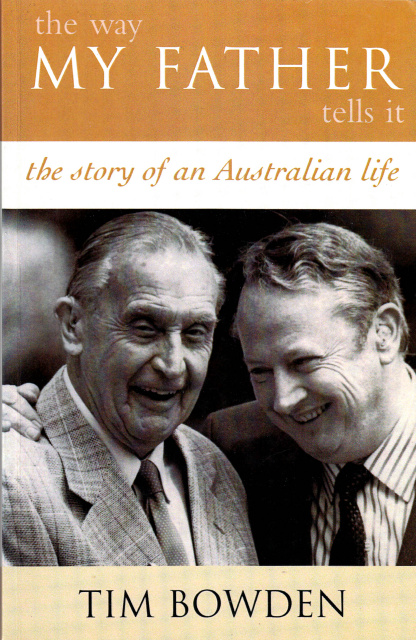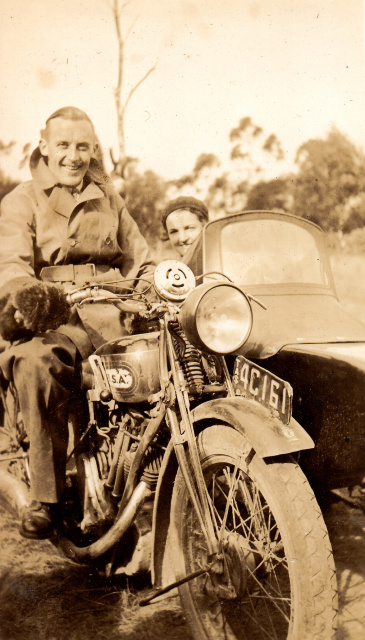In this third of his series of five articles, broadcaster Tim Bowden writes on a very personal form of recording a family history ... something from which I think we could all learn.
A different oral history
By Tim Bowden
Like many Australian families, I did not really know a great deal about our own family history.
My father was the youngest of six children, and the last of them alive. He was born in 1906 and lived for nine decades. But I suppose in many ways the writing of The Way My Father Tells It can be seen as the ultimate indulgence for someone working in the field of oral history. I do plead, however, some mitigating circumstances. When I worked in the Social History Unit of the ABC we were continually cajoling – even bullying – people to record their own family histories. Because we couldn't do it all.
 I was well aware that my father not only remembered the events of his own generation, but indeed several generations before that. It was only later that I came to realise that the chronological reach he commanded was extraordinary.
I was well aware that my father not only remembered the events of his own generation, but indeed several generations before that. It was only later that I came to realise that the chronological reach he commanded was extraordinary.
His father, my grandfather Frank Prosser Bowden, was born in 1860. My father, John Gibson Bowden, was born before the First World War.
He was trying to earn a living during the Depression, he served in the AIF during the Second World War, and he was selling Holden cars in the 1950s. This meant that he was of that last surviving generation able to speak of almost the entire 20th Century.
These thoughts were to come later. My first priority in 1983 was to get him started on a family-related oral history project that first had to overcome the tyranny of distance. I was in Sydney: he was in Hobart. My mother, Peg, had died in 1982 after two decades of struggle with that cruellest of diseases, rheumatoid arthritis. This long illness had brought my parents even closer together – if such a thing were possible.
Some rough guidelines...
After he had emerged from the initial deep grief of her passing, I suggested to him that he chat into a tape recorder about his early life, and growing up in the Hobart of 1910-1920. I sent him down some very rough guidelines.

'Talk about how you lived', I wrote. 'Describe the house, the services that came to the house, the relationships between family members, what you ate, who came to the house, how you travelled about, entertainment.'
I encouraged him to let his mind range freely down by-roads to deal with things as they occurred to him, even if a certain story emerged that he had not thought of when he started to record.
Ranging freely down by-roads, 1934.
As it happened, talking into a tape recorder was not something that he had difficulty with. He and Peg used to exchange letter tapes with the Bowdens in Sydney.
We would set up a machine – often during the chaos of a family evening meal – and shout at it during dinner. In return he and Peg would set up their cassette tape recorder in the evenings – sometimes the clink of ice cubes in a glass could be clearly heard – and chat away to us.
And so we began. He had a large Sony cassette recorder with two stereo microphones built in on the front of the machine, which was a 'ghetto blaster' in the parlance of the day.
Remarkably, the sound quality was quite good. The tapes started arriving, and I listened to them and began transcribing them.
I should say at this point that I had no thought of producing a book for general consumption. My first aim was to record the material for the family archives, and I had a loose idea of perhaps doing up some kind of primitive publication, using computer type-setting, and photocopying some of the photographs to produce a few copies for interested family members.
But as the material came in, I thought it was of high quality, and the idea of doing a book for a wider distribution was canvassed.
Something special was happening...
By early 1987 there was a fair stack of transcripts, and I was aware that something rather special was happening.
You see, under normal circumstances, I would conduct a face-to-face interview to obtain oral history material. This is a tried and true technique that works well. But as I listened to John's tapes, I became conscious that I was hearing a very different style of oral history from the programs I was making myself.
In the normal course of events, the interviewer profoundly directs the course and structure of a recording. By the very act of asking a particular question, the interviewee is guided down a certain path. The interviewer may find one aspect of a story especially interesting, and ask further questions about it, so is very much in control of the agenda.
But in the case of John's tapes, his mind was ranging freely over the general brief, and quite clearly anecdotes and impressions were occurring to him as he went along. This was often expressed in what I thought were very amusing anecdotes which would come to him as he was taping. The point is that they might not have been stories he had thought of before he started.
The stories might have been lost...
One, I recall, centred around a local band leader and notable character of Hobart in the 1920s, Tommy Hopkins. One of Tommy’s jobs was to compose music to accompany the silent films, and here's the story the way my father told it:
JOHN BOWDEN: Tommy worked out a musical program for this particular film, and in it the man playing - shall we say the flute - had a 20 bar rest. The interval came, and the owner of the picture theatre came to Tommy Hopkins, and said: 'Why is that bloke not playing his flute'?
And Tommy said: 'Oh, he's got a long 20 bar best. He doesn't have to play then.'
And the bloke said: 'Well why doesn't he'?
Tommy said: 'It's not in the music'.
The man said: 'Well can't you get some music that makes them all play, all the time? I'm not paying these blokes to sit on their arses and do nothing'!
On another occasion he was recalling his early married life in 1934, when he and my mother Peg dabbled in repertory theatricals with the Douglas Caddy Players in Launceston.
Father was an automotive electrician by trade, and helped with the stage lighting. But every now and then he used to be given a walk on line or two to keep him involved – presumably so he wouldn't take Peg away from the company. On one of these occasions he claims to have perpetrated one of the great stage Spoonerisms of all time:
'I had a small part in which I had to come in and do a scene with a big business tycoon. One of my few lines, I only had about three, was to say: 'I'm afraid that I'm not quite so far sighted as you are Sir'. And what I actually said was... and incidentally this was the last night, and I had been imbibing a little behind the stage - always dangerous when you are acting, or in my case, pretending to bloody well act. And I came on in very good form for my last performance, and what I did say when I came to this brilliant line was:
'I'm afraid I'm not quaite so sai farted as you are Sir...'!
And that didn't seem to be quite right, so I tried, and I actually said three other variations - none of them correct - and on the third one the producer called out from the wings, 'Stop him somebody'! The audience was on its feet cheering! Anyway I was led off, and I don't think I was really offered any parts much after that.
I wonder why. But the point of that story is, I suppose, that it may not have been recorded had I been interviewing John face to face. I might have asked him to talk about something else.
Here is another story he told about early married life, in 1935. He and my mother Peg had not long moved to Hobart, where they rented a little cottage in the grounds of the historic home Runnymede. My mother later became a formidable gourmet cook, but in the first few months of her married life she had a long way to go.
JOHN BOWDEN: For Sunday lunch, Sunday midday, we had roast leg of lamb, and we just carried this on for a little while with cold lamb - through Monday and Tuesday. And I finally said, 'Couldn't we have a change from roast lamb'? And she said, 'What a good idea'. So next time (laughs) ... the butcher called in those days, drove up the drive to our little cottage in his horse and cart, and got out and came to the door, and said: 'What'd you like lady?'
Peggy said: 'Well, I'd like a leg of beef for a change.'
Well he started to laugh at the back door, he managed to explain to Peg that there was a difference between a leg of beef and a leg of lamb in size, and Peg says she could hear this laughter ringing around the district as he drove away (laughs). But we never had our leg of beef, but I think we had a roast of beef. He explained that to her when he got over his mirth.
I told him not to worry about chronology. The important thing was for him to talk about his life as events and anecdotes occurred to him. I said I would sort it out later – and if there were missing links, I would then ask him to provide them.
It could be argued that what I was getting in the tapes from Hobart was a more pure style of oral history than would have achieved had I been sitting with him asking questions and shaping the detailed agenda, rather than leaving it to him.
* * *
In the next article, the transcripts continue. The possibility of a book is considered, with ABC Books expressing interest in publishing it.
Tim Bowden’s website is www.timbowden.com.au, where copies of his available books can be ordered.
Photo credits:
The Way My Father Tells It: book cover, courtesy Tim Bowden
John and Peg Bowden on their motorbike 1934, courtesy Tim Bowden.
Audio tapes: John Bowden, courtesy Tim Bowden.
